How to Choose a Bike Rack for a Sedan or Hatchback
If you drive a sedan such as a Toyota Corolla, Chevy Cruze, and Dodge Charger, the following racks will work well for you. You can choose from among hitch-mounted, roof-mounted, or trunk-mounted rack styles.
Learn more about these three main types of bike racks:
- Hitch-mounted - these racks attach to a hitch at the back of your vehicle
- Roof-mounted - these attach to a roof rack system that has crossbars
- Trunk-mounted - these racks attach to the trunk, hatch, or rear doors of your sedan or hatchback
Hitch-Mounted Bike Racks
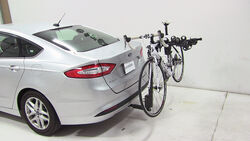
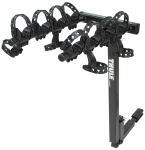
Hitch-mounted bike racks are easy to mount and remove from your car - you just slide them into or out of a hitch and secure them with a pin or lock. Bikes are usually easy to load, too, on hitch-mounted racks because you don't have to lift the bikes very high or remove any wheels. The only contact these racks have with a car is at the hitch, so you won't risk damaging your vehicle's paint. If you need to open the trunk of your vehicle while the rack is installed, consider a folding or swing-away rack. These models either tilt down or swing out on hinges to allow you to get into your car's trunk or hatch.
If your car doesn't have a hitch, you can install one. Most hitches can be installed with basic hand tools and don't require drilling into your car. See our fitguide to find a custom-fit hitch for your car.
Pros:
- Easy to install and remove
- Easy to mount bikes
- Large capacity - up to 5 bikes
- No damage to vehicle finish
Cons:
- Interferes with trunk access
- Requires a hitch
- Prevents use of hitch for towing
- Specialty towing bike racks allow you to tow
Roof-Mounted Racks


Roof-mounted bike racks attach to a car's crossbars, so they keep your bikes up out of your way. This makes it easy to open the trunk or hatch of your vehicle whenever you need to, which is handy, especially if you haul bikes frequently. Roof racks can be left on your car when you're not using them, and you'll hardly notice they are there.
You can carry more than 1 bike on your roof; however, you'll need a rack for each bike. The maximum number of bikes that you can carry will be limited by the width of your vehicle's crossbars and the maximum capacity of both the crossbars and your car's roof. And keep in mind that if you want to carry more than 2 bikes, you'll have to mount some of them near the center of your vehicle's roof, which means that you will have to hold a bike out far from your body to load it. This can be difficult for some people.
If your sedan doesn't have crossbars, you can have them installed or install them yourself. See our fitguide to find a custom-fit rack for your vehicle.
Pros:
- Easy to install and remove
- Allows full access to back of vehicle
- No damage to vehicle finish
Cons:
- Bike loading can be awkward
- Requires crossbars
- Requires a rack for each bike
Trunk-Mounted Racks
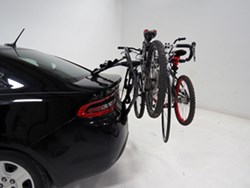

Trunk-mounted bike racks are usually the most economical type of rack, especially if your car doesn't already have a hitch or crossbars. These racks attach to your vehicle's trunk or hatch by means of hooks, straps, and buckles. These racks usually have pads at the mounting points to avoid damage to your vehicle's finish. But it's a good idea to make sure the contact points of your car are clean and free of dirt before mounting the rack to help eliminate possible scuffing or scratching of the paint. Also, you can't open your trunk or hatch while a trunk-mounted rack is installed, so your access to the back of your car is restricted. And if your vehicle has a spoiler, be sure to choose a rack that is designed to clear this type of accessory.
Pros:
- Requires no hitch or crossbars
- Least expensive option
- Can be swappped among different vehicles
(check fit information)
Cons:
- Limits trunk access
- More difficult to install
- Potential damage to vehicle finish
Additional Articles
How to Choose a Hitch-Mounted Bike Rack
How to Choose a Roof-Mounted Bike Rack
How to Chosse a Trunk-Mounted Bike Rack
Written by: Raymond P.
Last updated: 1/12/18
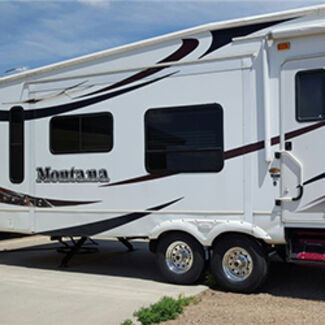
Victor M.
11/17/2021
I have a 2018 Corolla Im hatchback. It's the same hitch assembly! I need also ebike fat tire bike rack?
Departments
Towing
- Trailer Hitch
- Fifth Wheel
- Gooseneck
- Towing a Vehicle
- Front Hitch
- RV Hitch
- ATV Hitch
- HD Truck Hitch
- Vehicle Wiring
- Brake Controller
- Ball Mounts
- Weight Distribution
Sports and Recreation
Trailer Parts
- Utility Trailer
- Boat Trailer
- Landscape Trailer
- Enclosed Trailer
- 5th/Camper Trailer
- Car Hauler
- Horse Trailer
Vehicle
Contact & Help

What our customers are saying:
"Quick processing, and delivery. reasonably priced very satisfied"


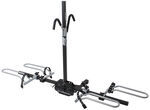




 Shop Trunk-Mounted Bike Racks
Shop Trunk-Mounted Bike Racks
John B.
3/1/2022
I have a 2022 Honda Civic hatchback and need a bike rack solution for both road and mountain bikes. I see your roof rack options, but am worried that the height of the open hatch may require a roof bike rack too be placed too far forward? Do you see any problem with this for 29er mountain bikes? 2 other questions bout the 2022 Civic hatchback: 1) Is there a trunk mounted rack option, such as Saris or Thule? 2) is there a Draw-Tite or other option for hitch mounted racks? Thank you, John B